Related Research Articles

HMS Ocean was a Royal Navy Colossus-class light fleet aircraft carrier of 13,190 tons built in Glasgow by Alexander Stephen & Sons. Her keel was laid in November 1942, and she was commissioned on 8 August 1945.

The Royal Naval Reserve (RNR) is one of the two volunteer reserve forces of the Royal Navy in the United Kingdom. Together with the Royal Marines Reserve, they form the Maritime Reserve. The present RNR was formed by merging the original Royal Naval Reserve, created in 1859, and the Royal Naval Volunteer Reserve (RNVR), created in 1903. The Royal Naval Reserve has seen action in World War I, World War II, the Iraq War, and War in Afghanistan.

HMS Northumberland is a Type 23 frigate of the Royal Navy. She is named after the Duke of Northumberland. She is the eighth RN ship to bear the name since the first 70-gun ship of the line in 1679, and the ninth in the class of Type 23 frigates. She is based at Devonport and is part of the Devonport Flotilla.

HMS Arrow was a Type 21 frigate of the Royal Navy.
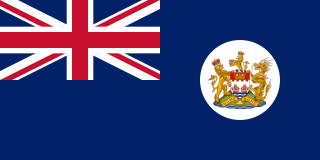
British Forces Overseas Hong Kong comprised the elements of the British Army, Royal Navy and Royal Air Force stationed in British Hong Kong. The Governor of Hong Kong also assumed the position of the commander-in-chief of the forces and the Commander British Forces in Hong Kong took charge of the daily deployment of the troops. Much of the British military left prior to the handover of Hong Kong to China in 1997. The present article focuses mainly on the British garrison in Hong Kong in the post Second World War era. For more information concerning the British garrison during the Second World War and earlier, see the Battle of Hong Kong.

The Commander-in-Chief Fleet (CINCFLEET) was the admiral responsible for the operations of the ships, submarines and aircraft of the British Royal Navy from 1971 until April 2012. The post was subordinate to the First Sea Lord, the professional head of the Naval Service. In its last years, as the Navy shrank, more administrative responsibilities were added.
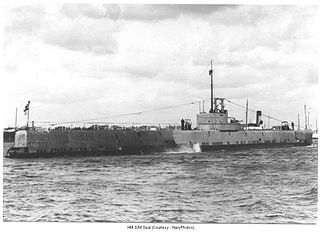
HMS Seal was one of six Grampus-class mine-laying submarines of the Royal Navy. She served in the Second World War and was captured by the Kriegsmarine and taken into German service as UB, one of several captured subs. She was the only submarine the Germans captured at sea during World War II. Her capture allowed the Germans to correct a critical fault in their U-boat torpedoes.

The Marine Society is a British charity, the world's first established for seafarers. In 1756, at the beginning of the Seven Years' War against France, Austria, and Saxony Britain urgently needed to recruit men for the navy. Jonas Hanway (1712–1786), who had already made his mark as a traveller, Russia Company merchant, writer and philanthropist, must take the chief credit for founding the society which both contributed to the solution of that particular problem, and has continued for the next two and a half centuries to assist many thousands of young people in preparing for a career at sea.

HMD Bermuda was the principal base of the Royal Navy in the Western Atlantic between American independence and the Cold War. The Imperial fortress colony of Bermuda had occupied a useful position astride the homeward leg taken by many European vessels from the New World since before its settlement by England in 1609. French privateers may have used the islands as a staging place for operations against Spanish galleons in the 16th century. Bermudian privateers certainly played a role in many English and British wars following settlement, with its utility as a base for his privateers leading to the Earl of Warwick, the namesake of Warwick Parish, becoming the most important investor of the Somers Isles Company. Despite this, it was not until the loss of bases on most of the North American Atlantic seaboard threatened Britain's supremacy in the Western Atlantic that the island assumed great importance as a naval base. In 1818 the Royal Naval Dockyard, Bermuda officially replaced the Royal Naval Dockyard, Halifax, as the British headquarters for the North America Station (which would become the North America and West Indies Station after absorbing the Jamaica Station in 1830.
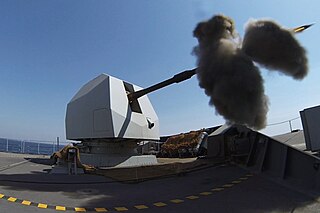
The 4.5 inch Mark 8 is a British naval gun system which currently equips the Royal Navy's destroyers and frigates, and some British destroyers and frigates sold to other countries.
Captain Addison Joe Baker-Cresswell DSO was a Royal Navy officer, aide-de-camp to King George VI and High Sheriff of Northumberland. He is noted prominently for his role as the commanding officer of HMS Bulldogduring the capture of U-110, from which an intact Enigma cipher machine was seized.

HMS Tiptoe was a British submarine of the third group of the T class. She was built by Vickers Armstrong, Barrow, and launched on 25 February 1944. She was one of two submarines named by Winston Churchill, and so far has been the only ship of the Royal Navy to be named Tiptoe. In 1955 she was involved in a collision with a coastal steamer whilst in Tromsø harbour. She was involved in escape trials off Malta in 1962, and the commanding officer was reprimanded in 1964 following an incident in the Firth of Clyde where she was run aground, and again in 1965 when she collided with HMS Yarmouth. Although originally named for the ability to sneak up on someone undetected, she maintained several links with ballet, including the Royal Ballet and ballet dancer Moira Shearer. She was scrapped at Portsmouth in 1975, while her anchor is on display in Blyth, Northumberland.
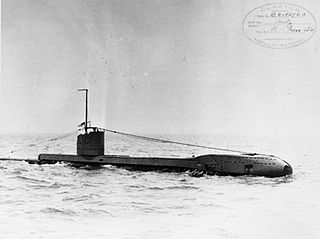
HMS Unity was a U-class submarine, of the first group of that class constructed for the Royal Navy. The submarine entered service in 1938 and performed war patrols during the Second World War. On 29 April 1940, Unity was accidentally rammed and sunk in Blyth, Northumberland's harbour.
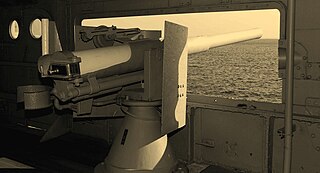
The QF 12-pounder 12-cwt gun (Quick-Firing) was a common, versatile 3-inch (76.2 mm) calibre naval gun introduced in 1894 and used until the middle of the 20th century. It was produced by Armstrong Whitworth, Elswick and used on Royal Navy warships, exported to allied countries, and used for land service. In British service "12-pounder" was the rounded value of the projectile weight, and "12 cwt (hundredweight)" was the weight of the barrel and breech, to differentiate it from other "12-pounder" guns.

HMS Royal Arthur was a shore establishment of the Royal Navy, initially at Ingoldmells near Skegness, and later at Corsham, Wiltshire. During the Second World War, the former holiday camp at Ingoldmells was used to mainly train 'Hostilities Only' communications branch ratings and officers.
One ship and one shore establishment of the Royal Navy have borne the name HMS Standard, a term for a war flag:
Empire Cymric was a 4,820 GRT Ferry that was built in 1944 by Harland & Wolff Ltd, Belfast as LST (3) HMS LST 3010 for the Royal Navy. She was transferred to the Koninklijke Marine in 1945, serving as HNLMS LST 3010. In 1947, she was transferred back to the Royal Navy and renamed HMS Attacker. The ship was requisitioned by the Ministry of Transport in 1954 and renamed Empire Cymric. Requisitioned briefly during the Suez Crisis in 1956 as HMS Empire Cymric, she served until 1962, and was scrapped in 1963.

HMS Caesar was one of thirty-two C-class destroyers built for the Royal Navy during the Second World War, a member of the eight-ship Ca sub-class. Commissioned in 1944, she was built as a flotilla leader with additional accommodation for staff officers. The ship was assigned to Home Fleet during 1944–1945 and escorted one Arctic convoy as well as the capital ships of the fleet.

HMS Haydon was a Hunt-class destroyer of the Royal Navy. She was a member of the third subgroup of the class, and saw service in the Second World War. Most of the ships of this class were named after British fox hunts. She was the first Royal Navy warship to bear this name, after the Haydon hunt in Northumberland. In 1942 she was adopted by the civil community of Wallsend in Northumberland, as part of Warship Week.
References
- Prewer, Surgeon Lt-Cdr Richard Russell (1945). "The Kielder Experiment". Journal of Mental Science. 91 (385): 481–494. doi:10.1192/bjp.91.385.481.
55°12′35″N2°33′14″W / 55.20972°N 2.55389°W